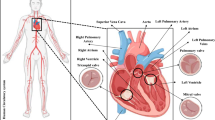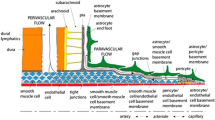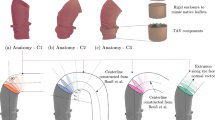Abstract
Hemodynamics is a risk factor in intracranial aneurysms (IA). Hypertension and pharmacologically induced hypotension are common in IA patients. This study investigates how hypertension and hypotension may influence aneurysmal hemodynamics. Images of 23 IAs at typical locations were used to build patient-specific Computational Fluid Dynamics models. The effects of hypotension and hypertension were simulated through boundary conditions by modulating the normotensive flow and pressure waveforms, in turn produced by a 1D systemic vascular model. Aneurysm location and flow pattern types were used to categorize the influence of hypotension and hypertension on relevant flow variables (velocity, pressure and wall shear stress). Results indicate that, compared to other locations, vertebrobasilar aneurysms (VBA) are more sensitive to flow changes. In VBAs, space-averaged velocity at peak systole increased by 30% in hypertension (16–21% in other locations). Flow in VBAs in hypotension decreased by 20% (10–13% in other locations). Momentum-driven hemodynamic types were also more affected by hypotension and hypertension, than shear-driven types. This study shows how patient-specific modeling can be effectively used to identify location-specific flow patterns in a clinically-relevant study, thus reinforcing the role played by modeling technologies in furthering our understanding of cardiovascular disease, and their potential in future healthcare.









Similar content being viewed by others
Abbreviations
- IA:
-
Intracranial aneurysm
- CFD:
-
Computational fluid dynamics
- 3DRA:
-
Three-dimensional rotational angiography
- ICA:
-
Internal carotid artery
- MCA:
-
Middle cerebral artery
- PCOM:
-
Posterior communicating artery
- VBA:
-
Vertebrobasilar artery
- SBP:
-
Systolic blood pressure
- DBP:
-
Diastolic blood pressure
- MD:
-
Momentum-driven
- SD:
-
Shear-driven
- MV:
-
Maximum velocity at peak systole
- SavV:
-
Space-averaged velocity at peak systole
- MTavV:
-
Maximum time-averaged velocity
- TavV:
-
Time-averaged velocity
- STavV:
-
Space-and-time-averaged velocity
- WSS:
-
Wall shear stress
- TavWSS:
-
Time-averaged wall shear stress
- STavWSS:
-
Space-and-time-averaged wall shear stress
References
Bijlenga, P., and @neurIST investigators. Risk of rupture of small anterior communicating artery aneurysms is similar to posterior circulation aneurysms. Stroke 44:3018–3026, 2013.
Bonert, M., J. G. Myers, S. Fremes, J. Williams, and C. R. Ethier. A numerical study of blood flow in coronary artery bypass graft side-to-side anastomoses. Ann. Biomed. Eng. 30:599–611, 2002.
Boussel, L., V. Rayz, C. McCulloch, A. Martin, G. Acevedo-Bolton, M. Lawton, R. Higashida, W. S. Smith, W. L. Young, and D. Saloner. Aneurysm growth occurs at region of low wall shear stress: patient-specific correlation of hemodynamics and growth in a longitudinal study. Stroke 39:2997–3002, 2008.
Bowker, T. J., P. N. Watton, P. E. Summers, J. V. Byrne, and Y. Ventikos. Rest versus exercise hemodynamics for middle cerebral artery aneurysms: a computational study. AJNR Am. J. Neuroradiol. 31:317–323, 2010.
Cebral, J. R., and H. Meng. Counterpoint: realizing the clinical utility of computational fluid dynamics—closing the gap. AJNR. Am. J. Neuroradiol. 33:396–398, 2012.
Cebral, J. R., F. Mut, J. Weir, and C. Putman. Quantitative characterization of the hemodynamic environment in ruptured and unruptured brain aneurysms. AJNR Am. J. Neuroradiol. 32:145–151, 2011.
Cebral, J. R., F. Mut, J. Weir, and C. M. Putman. Association of hemodynamic characteristics and cerebral aneurysm rupture. AJNR Am. J. Neuroradiol. 32:264–270, 2011.
Dempere-Marco, L., E. Oubel, M. Castro, C. Putman, A. Frangi, and J. Cebral. CFD analysis incorporating the influence of wall motion: application to intracranial aneurysms. Med. Image Comput. Comput. Assist. Interv. 9:438–445, 2006.
Ghods, A. J., D. Lopes, and M. Chen. Gender differences in cerebral aneurysm location. Front. Neurol. 3:78, 2012.
Humphrey, J., and S. Na. Elastodynamics and arterial wall stress. Ann. Biomed. Eng. 30:509–523, 2002.
Humphrey, J. D., and C. A. Taylor. Intracranial and abdominal aortic aneurysms: similarities, differences, and need for a new class of computational models. Annu. Rev. Biomed. Eng. 10:221–246, 2008.
Jou, L.-D., D. H. Lee, H. Morsi, and M. E. Mawad. Wall shear stress on ruptured and unruptured intracranial aneurysms at the internal carotid artery. AJNR Am. J. Neuroradiol. 29:1761–1767, 2008.
Lam, A. M., and A. W. Gelb. Cardiovascular effects of isoflurane-induced hypotension for cerebral aneurysm surgery. Anesth. Analg. 62:742–748, 1983.
Les, A. S., S. C. Shadden, C. A. Figueroa, J. M. Park, M. M. Tedesco, R. J. Herfkens, R. L. Dalman, and C. A. Taylor. Quantification of hemodynamics in abdominal aortic aneurysms during rest and exercise using magnetic resonance imaging and computational fluid dynamics. Ann. Biomed. Eng. 38:1288–1313, 2010.
Malek, A. M., S. L. Alper, and S. Izumo. Hemodynamic shear stress and its role in atherosclerosis. JAMA 282:2035–2042, 1999.
Meng, H., V. M. Tutino, J. Xiang, and A. Siddiqui. High WSS or Low WSS? Complex interactions of hemodynamics with intracranial aneurysm initiation, growth, and rupture: toward a unifying hypothesis. AJNR Am. J. Neuroradiol. 35:1254–1262, 2014.
Mitchell, P., A. Gholkar, R. R. Vindlacheruvu, and A. David Mendelow. Unruptured intracranial aneurysms: benign curiosity or ticking bomb? Lancet Neurol. 3:85–92, 2004.
Nixon, A. M., M. Gunel, and B. E. Sumpio. The critical role of hemodynamics in the development of cerebral vascular disease: a review. J. Neurosurg. 112:1240–1253, 2010.
Reymond, P., F. Merenda, F. Perren, D. Rüfenacht, and N. Stergiopulos. Validation of a one-dimensional model of the systemic arterial tree. Am. J. Physiol. Heart Circ. Physiol. 297:H208–H222, 2009.
Rinkel, G. J. E., M. Djibuti, M. Djibuti, A. Algra, and J. van Gijn. Prevalence and risk of rupture of intracranial aneurysms: a systematic review. Stroke 29:251–256, 1998.
Sforza, D. M., C. M. Putman, and J. R. Cebral. Hemodynamics of cerebral aneurysms. Annu. Rev. Fluid Mech. 41:91–107, 2009.
Shojima, M., M. Oshima, K. Takagi, R. Torii, M. Hayakawa, K. Katada, A. Morita, and T. Kirino. Magnitude and role of wall shear stress on cerebral aneurysm: computational fluid dynamic study of 20 middle cerebral artery aneurysms. Stroke 35:2500–2505, 2004.
Singh, P. K., A. Marzo, B. Howard, D. A. Rufenacht, P. Bijlenga, A. F. Frangi, P. V. Lawford, D. R. Hose, and U. J. Patel. Effects of smoking and hypertension on wall shear stress and oscillatory shear index at the site of intracranial aneurysm formation. Clin. Neurol. Neurosurg. 112:306–313, 2010.
Slosberg, P. S. Symptomatic unruptured giant aneurysms: medical treatment. Acta Neurochir. (Wien) 62:207–218, 1982.
Slosberg, P. S. Unexpected results in long-term medically treated ruptured intracranial aneurysm including data on 14 patients followed more than 30 years each. Acta Neurochir. (Wien) 139:697–705, 1997.
Suh, G.-Y., A. S. Les, A. S. Tenforde, S. C. Shadden, R. L. Spilker, J. J. Yeung, C. P. Cheng, R. J. Herfkens, R. L. Dalman, and C. A. Taylor. Hemodynamic changes quantified in abdominal aortic aneurysms with increasing exercise intensity using MR exercise imaging and image-based computational fluid dynamics. Ann. Biomed. Eng. 39:2186–2202, 2011.
Villa-Uriol, M. C., G. Berti, D. R. Hose, A. Marzo, A. Chiarini, J. Penrose, J. Pozo, J. G. Schmidt, P. Singh, R. Lycett, I. Larrabide, and A. F. Frangi. @neurIST complex information processing toolchain for the integrated management of cerebral aneurysms. Interface Focus 1:308–319, 2011.
Wu, J., A. T. Kraja, A. Oberman, C. E. Lewis, R. C. Ellison, D. K. Arnett, G. Heiss, J.-M. Lalouel, S. T. Turner, S. C. Hunt, Ma Province, and D. C. Rao. A summary of the effects of antihypertensive medications on measured blood pressure. Am. J. Hypertens. 18:935–942, 2005.
Xiang, J., S. K. Natarajan, M. Tremmel, D. Ma, J. Mocco, L. N. Hopkins, A. H. Siddiqui, E. I. Levy, and H. Meng. Hemodynamic—morphologic discriminants for intracranial aneurysm rupture. Stroke 42:144–152, 2011.
Acknowledgments
The research leading to these results has received funding from the European Union’s Sixth (FP6/2002-2006) and Seventh Framework Programme (FP7/2007–2013) under grant agreements no. FP6-IST- 027703 (@neurIST), no. FP7-ICT-601055 (VPH-DARE@IT), and no. FP7-ICT-69978 (VPH-Share). The authors would also like to acknowledge the computational support provided by the Department of Chemical Engineering, Isfahan University of Technology (IUT).
Author information
Authors and Affiliations
Corresponding author
Additional information
Associate Editor Umberto Morbiducci oversaw the review of this article.
Rights and permissions
About this article
Cite this article
Sarrami-Foroushani, A., Villa-Uriol, MC., Nasr Esfahany, M. et al. Modeling of the Acute Effects of Primary Hypertension and Hypotension on the Hemodynamics of Intracranial Aneurysms. Ann Biomed Eng 43, 207–221 (2015). https://doi.org/10.1007/s10439-014-1076-7
Received:
Accepted:
Published:
Issue Date:
DOI: https://doi.org/10.1007/s10439-014-1076-7




